
Entoloma hochstetteri, also known as the blue pinkgill, sky-blue mushroom or similar names, is a species of mushroom that is native to New Zealand. The small mushroom is a distinctive all-blue colour, while the gills have a slight reddish tint from the spores. The blue colouring of the fruit body is due to azulene pigments. Whether Entoloma hochstetteri is poisonous or not is unknown.

Crepidotus is a genus of fungi in the family Crepidotaceae. Species of Crepidotus all have small, convex to fan-shaped sessile caps and grow on wood or plant debris. The genus has been studied extensively, and monographs of the North American, European, and Neotropical species have been published.

Psilocybe weraroa, formerly Weraroa novae-zelandiae, is a secotioid fungus in the family Hymenogastraceae. It is endemic to New Zealand, where it grows in native forests from rotting wood and woody debris. Despite its pouch-like form this species is closely related to Psilocybe cyanescens and Psilocybe subaeruginosa. As a bluing member of the genus Psilocybe it contains the psychoactive compounds psilocin and psilocybin.
Aeruginospora furfuracea is a species of fungus in the family Hygrophoraceae. The species, described by Egon Horak in 1973, is found in New Zealand. It is currently placed in the genus Aeruginospora, but may actually belong in Camarophyllopsis.

Entoloma haastii is a mushroom in the Entolomataceae family. Described as new to science in 1964, it is known only from New Zealand, where it grows on the ground in leaf litter, usually near Nothofagus species.
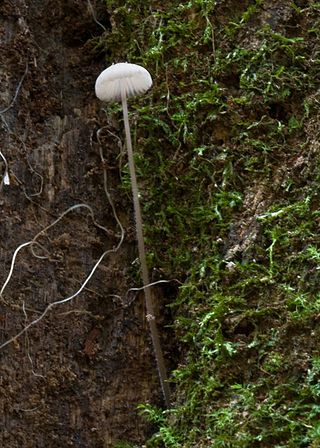
Mycena cystidiosa is a species of mushroom in the family Mycenaceae. Described as new to science in 1964, it is known only from New Zealand and Australia. The fruit bodies have a broadly conical small white cap up to 12 mm (0.5 in) wide, with distantly spaced cream-coloured gills on the underside. The stipe is particularly long, up to 20 cm (8 in), with an abundant covering of white hairs at the base. The species is known for its abundant rhizomorphs—long, root-like extensions of mycelia.

Hygrocybe procera is a colourful Hygrocybe (waxcap) fungus. First described as Hygrophorus procerus by Greta Stevenson in 1963, the species was transferred to Hygrocybe in 1971 by Egon Horak. It is only known with certainty from New Zealand.
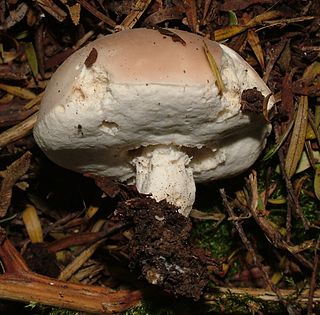
Boletus semigastroideus is a species of secotioid fungus in the family Boletaceae. It was originally described in 1942 as Secotium areolatum by New Zealand-based mycologist Gordon Herriot Cunningham and then renamed as Notholepiota areolata as the type species of the genus Notholepiota by Egon Horak in 1971. A molecular phylogenetics study found it to belong in Boletus sensu stricto, but the name Boletus areolatus was preoccupied, so it was renamed Boletus semigastroideus.

Pholiota nubigena, commonly known as the gastroid pholiota or the bubble gum fungus, is a species of secotioid fungus in the family Strophariaceae. It is found in mountainous areas of the western United States, where it grows on rotting conifer wood, often fir logs. It fruits in spring, often under snow, and early summer toward the end of the snowmelt period in high mountain forests. Fruit bodies appear similar to unopened mushrooms, measuring 1–4 centimetres tall with 1–2.4 cm diameter caps that are whitish to brownish. They have a short but distinct whitish stipe that extend through the internal spore mass (gleba) of the fruit body into the cap. The gleba consists of irregular chambers made of contorted gills that are brownish in color. A whitish, cottony partial veil is present in young specimens, but it often disappears in age and does not leave a ring on the stipe.
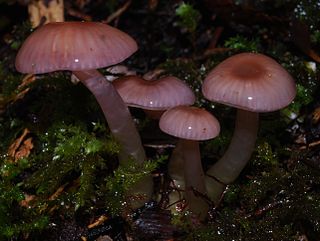
Gliophorus versicolor is a species of agaric fungus in the family Hygrophoraceae. Found in New Zealand, it was described as new to science in 1973 by mycologist Egon Horak. Within the genus Gliophorus, it is classified in the section Glutinosae, a grouping of species characterized by having bright colors, decurrent gills, and a gelatinized subhymenium. Fruit bodies have hemispherical to convex caps typically measuring 20 mm (0.8 in), although some have been recorded up to 50 mm (2.0 in). Moist caps are gluey with a color ranging from reddish brown to pinkish-lilac; the cap margin has radial grooves mirroring the gills underneath. The gills have an adnate to somewhat decurrent attachment to the stipe. They are widely spaced with color similar to the cap, or whitish. The cylindrical, hollow stipe measures 2–7 cm (0.8–2.8 in) by 1.5–3 mm (0.06–0.12 in) thick. The fungus is saprobic, and fruits on the ground among Dacrycarpus and Nothofagus.
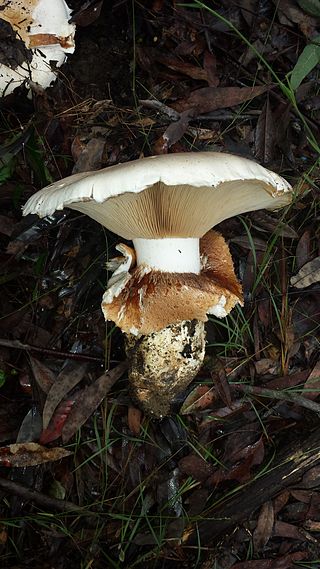
Austrocortinarius australiensis, commonly known as the skirt webcap, is a species of mushroom in the family Cortinariaceae which is native to Australia and New Zealand. The white mushrooms appear in autumn and can grow very large, with their caps reaching 30 cm (12 in) in diameter.
Egon Horak is an Austrian mycologist who has described more than 1000 species of fungi, including many from the Southern Hemisphere, particularly New Zealand and South America. He was an executive editor of the scientific journal Sydowia from 1975 to 1989, and a member of the editorial board afterwards.
Gliophorus bichromus is a species of agaric fungus in the family Hygrophoraceae. Found in New Zealand, it was described by mycologist Egon Horak in 1973.
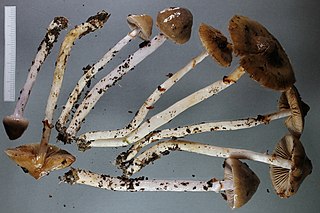
Cortinarius cucumeris is a basidiomycete fungus of the genus Cortinarius native to New Zealand, where it grows under Nothofagus.
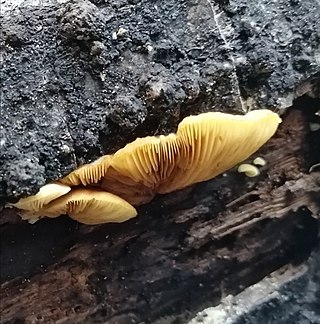
Crepidotus praecipuus is a species of fungus in the family Crepidotaceae first described in 2018. It is commonly known as a rusty-gilled conch, along with other kidney shaped, rusty-brown spored species of Crepidotus. It is saprobic on wood, like other Crepidotus species.

Crepidotus carpaticus, is a species of saprophytic fungus in the family Crepidotaceae with a stipeless sessile cap. The fungus was described by Albert Pilát in 1929 and is commonly found in France, the United Kingdom, and Ireland. The GBIF database indicates this species may be an orthographic variant.
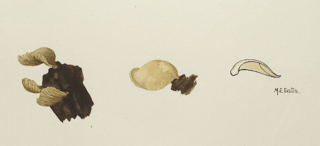
Crepidotus albescens is a species of saprophytic fungus in the family Crepidotaceae with a stipeless sessile cap.

Crepidotus albolanatus, is a species of saprophytic fungus in the family Crepidotaceae with a stipeless sessile finely felted cap. Colour is pure white, cap diameter 10–35 mm and has been found in New Zealand on the debris of the nikau palm.

Crepidotus brunnescens, is a species of saprophytic fungus in the family Crepidotaceae with a stipeless sessile cap which is smooth and yellowish-brown. It is often found on hardwood logs such as Quercus.
Amanita groenlandica is a species of fungus in the family Amanitaceae. It has been placed in Amanita sect. Vaginatae.
















